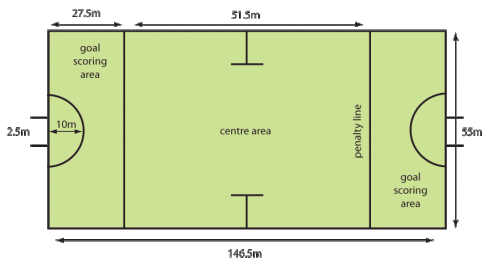How to Play
Players, Horses and Equipment
The racquet may be of any length, usually from 1m to 1.2m. The ball is made of thick- skinned sponge rubber, 100mm-103mm in diameter, and weighs 140-155grams.
Each player is permitted only one horse in each match or tournament, except in the case of injury when a substitute horse can be played. Although there is no restriction on the height of horses, it is generally accepted that the ideal height should not exceed 15.2 hands.
A team consists of six players, divided into two sections of three who play alternate chukkas of a maximum of eight minutes each, either six or eight chukkas usually comprising a full match. The three players in each section consist of a No. I or “Attack”, a No. 2 or “Centre”, and No. 3 or “Defence”.
The total aggregate of goals scored by the two sections in each team constitutes the final score.
The Field
The field is 146.5m long and 55m wide, with goal-posts 2.5m apart at each end.
Infield, 27.5m from each end there is a line extending the width of the field which is called the “penalty line”.
The line encloses what is known as the “Goal-scoring area”, in which only the No. 1 of the attacking team and the No. 3 of the defending team are allowed to play.
Directly in front of each goal there is a semi-circle of 10m radius, and the ball must be thrown at goal from outside this semi-circle, and within the goal-scoring area.
The No. 1 is the only player who can score a goal for the team and the No. 1 can only do so whilst in the goal-scoring area. The No. 2 is usually the pivot of the team, can only play in the centre area and the No. 3 is the only player who can defend a goal.
Playing Polocrosse
The game is begun in centre field, the players lining up side by side, one behind the other with the No. 1 or Attack in front, and the ball is thrown in by the umpire, over-arm, well above the players’ heads. The game recommences similarly after a goal has been scored. Whenever an attempt at goal fails, the No. 3 or Defence throws the ball back into play from just behind the penalty line, at a point directly in front of the spot where the ball crossed the back line. The umpire should indicate the spot from which the throw is to be taken.
Players pick up the ball from the ground, or catch it, in the net of the stick, and ride with it or throw it from player to player until the No. I or Attack is in possession of it in the goal-scoring area so as to be able to throw a goal.
A player cannot carry the ball over the penalty line, but must bounce it on the ground, so that that player does not have possession of it while actually crossing the penalty line. However, a player may throw the ball to another player across the line on the full.
A player carrying the ball in the stick must carry it on the stick side, i.e., right-handed players carry it on the off-side of the horse. A player cannot carry it across the horse, but the player can pick up or catch the ball on the non-stick side provided the player brings the stick back to the stick side immediately. Left-handed players are permitted.
Hitting at an opponent’s stick, either to dislodge the ball or prevent the opponent gaining possession of it, is allowed in an upward direction only. Hitting down constitutes a foul.
“Riding-off’ is allowed, but crossing, stopping over the ball, or elbowing constitute fouls. The wedging or sandwiching of one player between two players “riding-off” simultaneously constitutes a foul and is dangerous play.
The penalty for such fouls is a free throw to the offended side.


